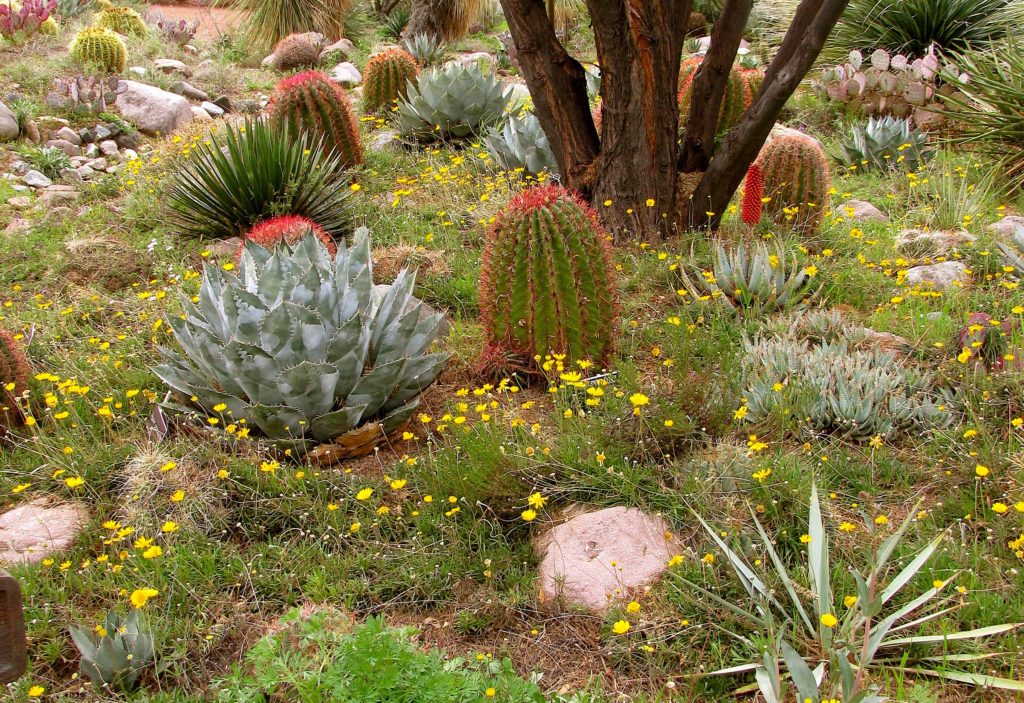Many of us garden for the pure aesthetics that a well-maintained landscape brings to our home. However, there is more to a garden than just beauty. As we consider the installation or renovations to our landscapes, it’s a great time to think about gardening sustainably. Our gardens can provide food and shelter for wildlife, insulate our homes, prevent water runoff leading to flooding, provide oxygen to the atmosphere, and provide food for us. Unfortunately, there are many gardens and landscapes that consume more resources than they provide. With a few tips, we can all garden in a more sustainable way.
Tip 1: Right Plant, Right Place
Before a garden is installed one should develop a landscape design. By evaluating the area beforehand, we can avoid mistakes. One of the biggest factors when designing a landscape is considering the plant’s mature size. Make sure that the plant has enough space to avoid constant shearing of shrubs into unsightly ‘biscuits’. Look up before planting a tree or a palm. Are there other trees in the way or overhead powerlines? Consider planting drought tolerant plants further away from the house and on high spots and more water hungry plants near the house and in lower spots where water will accumulate.
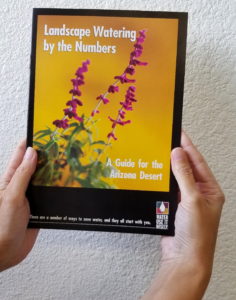
Tip 2: Know Your Watering Schedule
Most people that I have talked to water too frequently. One of the main keys to keeping your plants healthy is watering deeply but infrequently. Drip systems are designed to run for hours (NOT minutes) and not to run every day. There are no plants, including grasses, which need watering every day. Watering deeply allows for plant roots to reach deeper into the soil, making them more drought tolerant. If they are watered too shallowly, plant roots will develop only at the surface making them less drought tolerant, and prone to blowing over in a windstorm. For more information on how to properly water your desert landscape refer to this Water – Use It Wisely Landscape Watering Guide.
Tip 3: Water Harvesting
Many cities in Arizona offer rebates for rainwater collection systems. There are also rebates for installing new greywater systems that re-route water from washers and showers out the landscape. You can also install a passive rainwater system that delivers water from your gutter to collection swales with plantings in them.
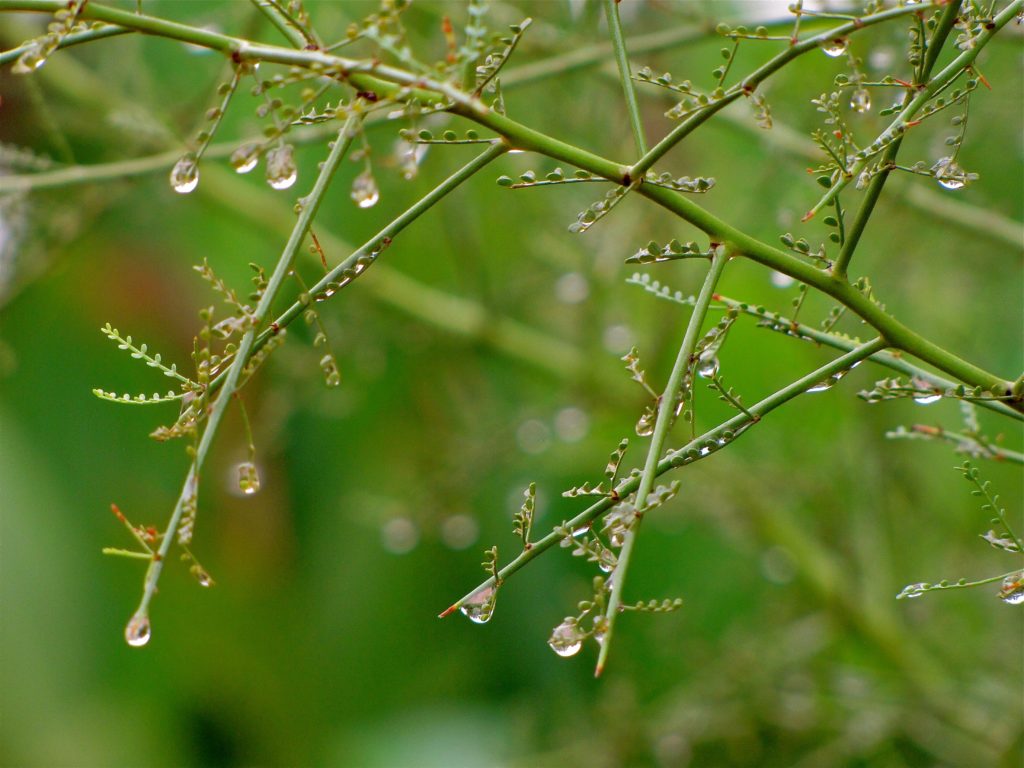
Tip 4: Leave Those Leaves!
Turning soft landscape debris into compost and mulch is a great way to build the soil and keep the soil insulated. By properly amending the soil with well decomposed compost, the soil will retain moisture for much longer, allowing for less frequent irrigation. A layer of mulch will also keep weeds down, keep the soil from drying out as quickly, and protect plant roots from heat and cold.
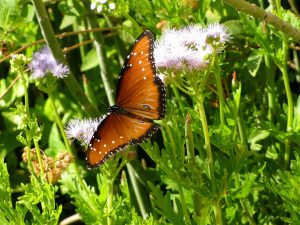
Tip 5: Plant for Pollinators
Instead of picking out plants for just beauty, pick plants that are known to be useful to pollinators. Hummingbirds love salvias, penstemons, and ocotillo. Butterflies love Conoclinium (mistflowers), milkweeds, passionvine, and pipevine. Bees love cactus flowers, asters, and Aloysia (lemon verbena). There are many lists of plants for pollinators that can be found with a simple Google search.
Tip 6: Keep Your Plants Healthy
Knowing your plant’s watering requirements, nutrition needs, and heat & cold tolerances can help you grow healthier plants. When your plants are healthy, they are less prone to detrimental pest and disease problems, which in turn means using fewer chemicals to keep them happy. It is also important to accept that there will always be minor damage on plants, but that such damage is not cause for chemical remediation. Limit the use of chemicals to only when pests or disease are truly causing harm to the plant. Also, never apply systemic pesticides to plants when they are in or near blooming time when pollinators go to the flowers.
Tip 7: Manage Invasives
Non–native invasive plants are detrimental to our natural environment. One of the biggest threats to the Sonoran Desert is invasive grasses brought over from Africa and Asia which provide fuel for wildfires. The plants here in the low desert, including our iconic saguaro, are not adapted to deal with fires which can alter the landscape for hundreds of years. Buffelgrass, red brome, and fountain grass are the major invasive grasses to watch out for in your garden. Pull them before they go to seed. However, there are also native bunchgrasses that provide seed for native birds and erosion control and do not provide enough fuel for fire. Before removing grasses, please find out whether they are native or not.
Tip 8: Penetrable Surfaces
Instead of pouring large slabs of concrete or asphalt, consider porous surfaces like landscape pavers, rock, or stabilized decomposed granite. Using penetrable surfaces helps mitigate heat island effect and also allows precipitation to infiltrate into the landscape rather than run off it, creating erosion and flooding.
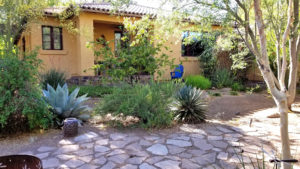
Tip 9: Limit Light Pollution
Landscape lighting can really highlight the architecture of the landscape at night. However, it can also confuse migrating wildlife and insects. It is ok to use landscape lighting; just turn off the lights when you are not in the landscape enjoying it.
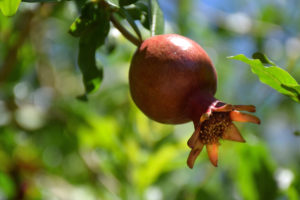
Tip 10: Incorporate Edibles into the Landscape
Instead of choosing plants that are purely ornamental, incorporate plants that you can eat! One of my favorite things to do with plant containers is fill them with a mix of annuals, herbs, and veggies. Plant petunias and Rudbeckia (coneflowers) among basil and use a tomato plant as the centerpiece, for example. The possibilities are endless. The annuals attract beneficial insects, and the overall look is contemporary and beautiful. You may not be able to grow enough veggies and fruit to keep up with your family’s needs, but it doesn’t take many herbs. A couple of fruit trees that take little water and care are pomegranates and quince.
Balancing aesthetics and sustainability is a little tricky, but it can be done. With these tips, I wish you the best success of gardening sustainably.
For further information, refer to:
- Water – Use It Wisely Landscape Watering Guide
- Harvesting Rainwater
- Landscape Plants for the Arizona Desert
- Invasive Plants – AZ Native Plant Society
- International Dark Sky Communities
- Plants for Enhancing Pollinator Habitat in Arizona
From time to time, Water – Use It Wisely features guest bloggers who write about topics related to water and water conservation. This article is being reprinted with permission by author Jason Wiley, the Director of Horticulture at Boyce Thompson Arboretum. Wiley has worked in public gardens for nine years, including the Anheuser-Busch Brewery in Fort Collins, CO, as the Landscape Supervisor and at the Phoenix Zoo as a Horticulturist. Before joining Boyce Thompson Arboretum, he was a Horticulturist at the Arizona-Sonora Desert Museum, where he maintained the Cactus Garden, Agave Garden, and various other gardens. The mission of Boyce Thompson Arboretum is to inspire appreciation and stewardship of desert plants, wildlife, and ecosystems through education, research, and conservation.


